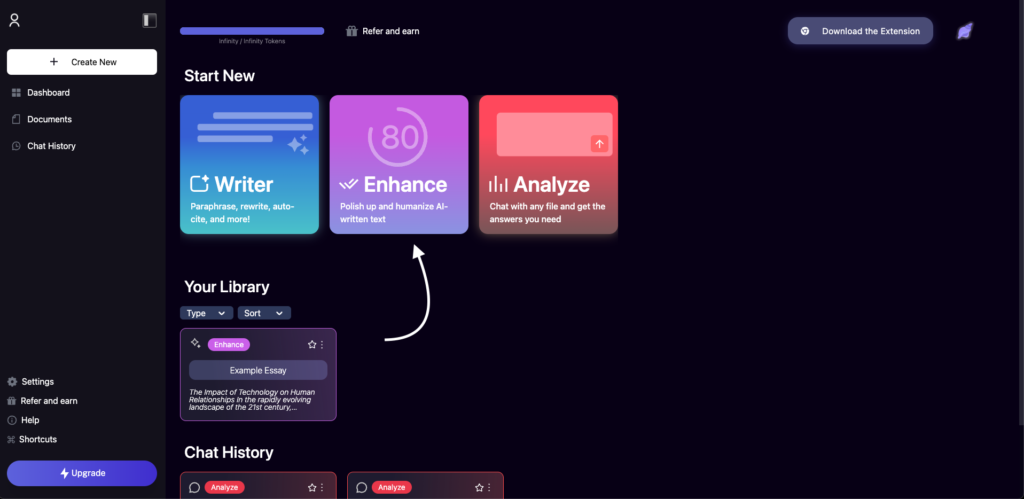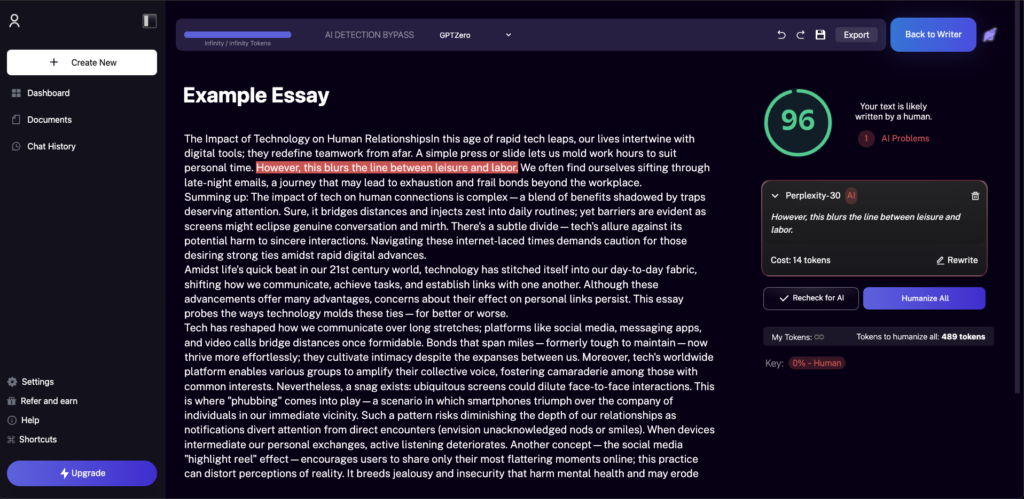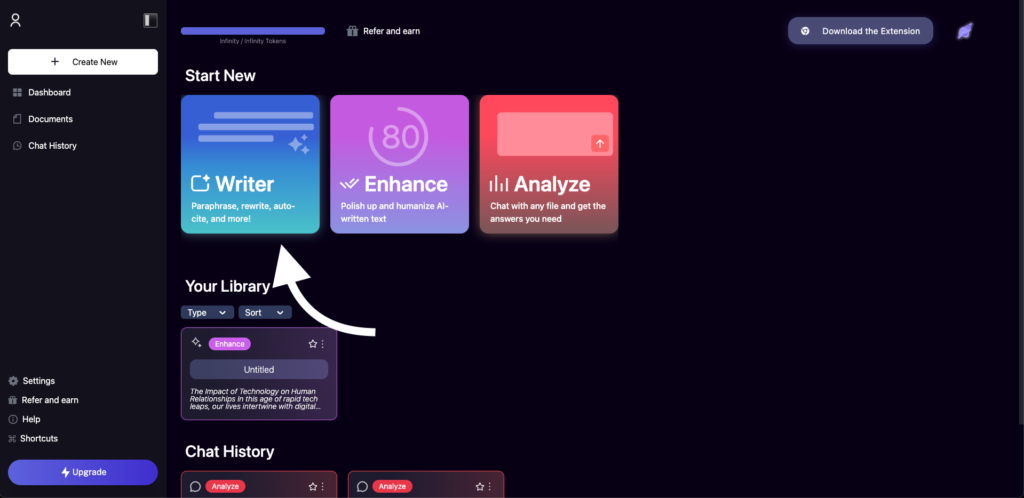
Welcome to the intriguing world of AI detection bypass, where the lines between human-generated and AI-generated content blur in a delicate dance of ingenuity and technological prowess.
In an era where artificial intelligence has transcended mere novelty to become an integral part of our digital landscape, and even the best AI detector tools are constantly challenged, it’s only natural that the constant interplay between AI detection tools and those attempting to outwit them has given rise to a captivating phenomenon.
This blog embarks on a journey into the realm of AI-generated text, exploring the methods, motives, and implications of evading AI detection mechanisms designed to differentiate between human and machine-written content. Join us as we delve into the art of AI detection bypass, uncovering the techniques employed by both AI creators and technology defenders in this evolving and intellectually stimulating cat-and-mouse game.
What Is AI Detection Bypass?
Have you ever wondered if the content you’re reading or writing was generated by an AI? With the rise of AI-powered content creation tools, it’s becoming increasingly difficult to distinguish between human-written and AI-generated content. This is where AI detection bypass tools come into play.
An AI detection bypass is a tool that helps you detect how much percentage of your content is AI written. It gives you a score indicating the likelihood of AI involvement in the content. But it doesn’t stop there. An AI detection bypass tool also helps you rewrite the content so that you can have a 99.9% chance of bypassing any AI detection tool.

Let me give you a great example…
Imagine being able to write content 10 times faster and still have the confidence that it won’t be flagged as AI-generated. That’s exactly what my app, Conch AI, does. We are the original AI bypass tool that not only helps you write at lightning speed but also ensures that your content flies under the radar of AI detection tools 99% of the time.
Using Conch AI is simple. You can either copy and paste your content into our app or use our browser extension to seamlessly integrate it into your existing workflow. Once you’ve done that, Conch AI analyzes your content and provides you with a detailed report on the AI involvement. This report includes a percentage score indicating the likelihood of AI-generated content.
But it doesn’t stop there. Conch AI also suggests alternative phrasing and word choices to help you reduce the AI element in your content. By incorporating these suggestions, you can significantly increase your chances of bypassing AI detection tools.
The beauty of Conch AI lies in its ability to adapt and evolve alongside AI detection algorithms. We constantly stay up to date with the latest advancements in AI detection technology to ensure that our users stay one step ahead. This means that as AI detection tools become more sophisticated, Conch AI will continue to provide accurate assessments and effective bypass strategies.
In a world where AI-generated content is becoming increasingly prevalent, it’s essential to have tools like Conch AI that empower humans to maintain their unique voice and creativity. With Conch AI, you can write faster, smarter, and with the confidence that your content will pass any AI detection test.
So, if you’re tired of spending hours writing content that might get flagged as AI-generated, give Conch AI a try. Join the thousands of writers, marketers, and content creators who have already harnessed the power of AI detection bypass. Start writing with speed and confidence today!
Related Reading
Can AI Detectors Be False?
Artificial intelligence (AI) has made tremendous progress in recent years, permeating various sectors of our lives. From chatbots to self-driving cars, AI is becoming increasingly sophisticated and seamlessly integrated into our daily routines. However, as with any technology, there are always vulnerabilities that can be exploited. In the realm of AI, one such vulnerability is the potential for AI detectors to be false.
AI detectors are designed to analyze and determine if a piece of text has been written by AI. These detectors are built upon complex algorithms and machine learning models, which are trained on vast amounts of data to recognize patterns and characteristics indicative of AI-generated content. The goal is to ensure that human-written content is accurately distinguished from AI-written content.

However, despite the advancements in AI technology, AI detectors can still produce false results. This can occur for several reasons. One of the main reasons is that AI detectors are only as good as the data they are trained on. If the training data does not adequately represent the wide range of AI-generated content, the detector may struggle to accurately detect AI writing.
Additionally, AI detectors may encounter challenges when faced with sophisticated AI models that have been specifically designed to bypass detection. These models can be trained to mimic human writing styles and patterns, making it difficult for detectors to differentiate between human and AI-generated content.
Furthermore, the rapid evolution of AI technology means that new AI models and techniques are constantly being developed. These advancements can outpace the capabilities of existing AI detectors, rendering them ineffective against newer, more sophisticated AI writing models.
Despite these challenges, AI detectors continue to improve and adapt. Researchers and developers are constantly working to enhance the accuracy and reliability of these detectors by refining the algorithms, expanding the training data, and incorporating new techniques.
While AI detectors have the potential to produce false results, they are an essential tool in the fight against AI-generated content. As AI technology continues to advance, it is crucial for AI detectors to evolve alongside it. By continually improving and refining these detectors, we can better protect ourselves from the potential dangers and misinformation that AI-generated content may pose.
Why Is An Example of An AI Detector?

Let’s kick things off by talking about TurnItIn. Many of you are probably familiar with this tool, especially if you’ve been through the education system. TurnItIn is widely used by schools and universities to detect plagiarism in students’ work. It works by comparing submitted content against a vast database of academic papers, articles, and websites. Using advanced algorithms, TurnItIn can identify similarities and flag potential instances of plagiarism. However, it’s important to note that TurnItIn is primarily designed to detect plagiarized content and may not be specifically tuned to detect AI-generated content.
Now, let’s move on to GPTZero. This tool is another powerful AI detector that has gained popularity in recent years. GPTZero is commonly used in the field of artificial intelligence itself to detect whether content has been generated by AI models, particularly GPT-3 and even GPT-4. Built on state-of-the-art deep learning techniques, GPTZero analyzes various linguistic and contextual aspects to make informed judgments about the source of a piece of content.
So, why do people use these AI detector tools? Well, the answer is simple. With the rise of AI-generated content, it’s crucial to ensure that the content we consume or publish is authentic and reliable. AI detection tools help us maintain the integrity and credibility of our work. In an era where misinformation and fake news are rampant, these tools provide an added layer of protection against AI-generated content that may be misleading or deceptive.
Now, let’s dive into how these tools detect whether content is AI-written or not. While the exact detection methods may vary between tools, there are a few common techniques employed. For example, AI detection tools often analyze the writing style, syntax, grammar, and vocabulary used in a piece of content. AI-generated content may exhibit certain patterns or inconsistencies that differ from human-written content. By comparing these linguistic features to known patterns of AI-generated content, the tools can make an educated guess about the origin of the text.
Another approach is to analyze the content for biases or logical inconsistencies that might be indicative of AI-generated content. We all know that AI is not perfect and can sometimes produce content that lacks coherence or exhibits biased opinions. AI detection tools are designed to pick up on these red flags and alert users to potential AI-generated content.
AI detection bypass is a crucial topic in today’s digital landscape. Tools like TurnItIn and GPTZero play a vital role in maintaining the authenticity and credibility of content. By analyzing linguistic features, writing style, and detecting biases, these tools provide an extra layer of protection against AI-generated content. As technology continues to evolve, so will the methods to detect AI-generated content, ensuring that we can trust the information we consume and publish.
Can AI Systems Be Fooled?
Artificial intelligence has come a long way in recent years, revolutionizing various industries and changing the way we interact with technology. From voice assistants to autonomous vehicles, AI is becoming increasingly sophisticated and capable of mimicking human behavior. But can AI systems be fooled? Specifically, can AI detector systems that are designed to detect if content is written by AI or not be bypassed?
The short answer is yes, AI systems can be fooled. While AI detector systems are designed to identify patterns and markers that indicate whether content is generated by a human or an AI, there are ways to bypass these detection mechanisms.

One method to bypass AI detection is to introduce errors or inconsistencies in the generated content. By intentionally inserting misspellings, grammar mistakes, or logical inconsistencies, AI-generated content can mimic the imperfections of human writing. This makes it harder for AI detectors to differentiate between human and AI-generated content.
Another way to bypass AI detection is by utilizing advanced language models that have been trained on a diverse range of human-written texts. These models, such as GPT-3 and GPT-4, are capable of generating highly coherent and contextually relevant content that closely resembles human writing. By leveraging the vast amount of knowledge and language patterns stored in these models, AI can produce content that is difficult for detectors to distinguish from human-generated content.
Furthermore, adversarial attacks can also be used to fool AI detection systems. Adversarial attacks involve intentionally manipulating the input to an AI system in order to trick it into making incorrect predictions or classifications. By carefully crafting the input data, it is possible to evade AI detectors and produce content that appears to be human-authored.
However, it is important to note that just because AI systems can be fooled, it does not mean that all AI detection systems are easily bypassed. AI developers and researchers are constantly working to improve the robustness and reliability of these systems. As new detection techniques and algorithms are developed, they become better equipped to identify AI-generated content, even in the face of bypass attempts.
While AI systems can be fooled, AI detection systems are not impervious to bypass. By introducing errors or inconsistencies, utilizing advanced language models, and employing adversarial attacks, it is possible to create AI-generated content that appears to be human-authored. However, it is important to remember that AI detection systems are also evolving and improving. As AI technology continues to advance, we can expect more sophisticated detection mechanisms to be developed, making it increasingly difficult to bypass AI detection.
Related Reading
- Free AI Detection Tool
- AI Plagiarism Checker
- Rephrase Chat GPT
- Chat GPT Paraphrasing Tool
- AI Text Rewriter
- How To Make Chat GPT Undetectable
Complete Step-by-Step Guide On How To Use Conch’s Free AI Detection Bypass Tool
By following this simple 7-step guide, you can easily check if your content is detected for plagiarism, and you can paraphrase it with Conch’s AI tool within minutes.
Conch’s plagiarism checker tool also paraphrases your content to bypass all AI writing detector systems, like GPTZero, Originality, Turnitin, and all other AI detection systems. It bypasses AI writing detectors 99% of the time and is trusted by millions of students around the world.
Here is a simple guide on how to use the tool:
Step 1: Login and Navigate To Our App
Step 2: Click Enhance To Analyze Your Content

Once you click Enhance you will be guided to Conch’s Enhance tool 👇

Step 3: Copy Your Essay Into Our Tool

Step 4: Click The ‘Check for AI’ Button In The Top-Right Corner

Step 5: Analyze The Results
Within minutes, our Enhance tool will analyze your content to determine it’s plagiarism score.

Step 6: Click ‘Humanize All’ To Automatically Paraphrase All of Your Content Within Minutes
This will paraphrase all of your content within minutes to save you from being questioned for plagiarism. It will also make your content AI-writing detector proof. You won’t have to worry about being detected by plagiarism checkers, nor will you have to worry about AI writing detectors detecting your content.

Before Enhancing The Content:

After Enhancing The Content:

Step 7: Copy or Export Your Content and Submit It With Ease

Bonus Step: Copy Your Content Into Our Writer Tool To Write An Applaudable Essay Within Minutes


Sign up to use our tool for free, today!
How Do AI Detection Bypass Tools Work?
Have you ever wondered if the content you’re reading or the emails you receive have been generated by AI? With the rapid advancements in artificial intelligence, it’s becoming increasingly difficult to distinguish between human-written and AI-generated content. That’s where AI detection bypass tools come in.
AI detection bypass tools are designed to help you detect AI-written content and give you a score indicating the percentage of AI involvement. But that’s not all they do. These tools also assist in rewriting the content so that you have a 99.9% chance of bypassing any AI detection tool out there.
So, let’s dive into how these AI detection bypass tools work and how they can benefit you.
Detecting AI Involvement
AI detection bypass tools use sophisticated algorithms to analyze different aspects of the content and determine the likelihood of AI involvement. They examine various features such as sentence structure, word choice, and grammar patterns to identify patterns commonly associated with AI-generated content.
By analyzing these features, the tool calculates a score indicating the percentage of AI involvement in the content. This score gives you a clear understanding of how much of the content you’re dealing with has been generated by AI.
Rewriting Content to Bypass AI Detection
Once the tool has detected AI involvement in the content, it’s time to take action. AI detection bypass tools provide you with a rewriting feature that helps you modify the content to reduce the chances of it being flagged by AI detection algorithms.
The rewriting feature utilizes advanced natural language processing techniques to rephrase and restructure the content in a way that mimics human writing. It ensures that the content maintains its original meaning and intent while minimizing the AI footprint.
By utilizing this rewriting feature, you can significantly increase your chances of bypassing any AI detection tool out there. This is particularly useful when you want to ensure that your content is perceived as genuinely human-written, especially in sensitive scenarios such as essays, professional articles, or customer communication.
The Importance of AI Detection Bypass Tools
AI detection bypass tools play a crucial role in combating the increasing prevalence of AI-generated content. As AI continues to advance, it’s becoming easier for malicious actors to create content that appears to be human-written. This can have serious implications, ranging from misinformation campaigns to fake product reviews.
By using AI detection bypass tools, you can protect yourself and your audience from falling victim to AI-generated content. These tools empower you to identify the extent of AI involvement and make informed decisions about the content you consume or publish.
AI detection bypass tools are invaluable assets in today’s AI-driven world. They enable you to detect AI-generated content and provide you with a score indicating the percentage of AI involvement. Additionally, these tools offer a rewriting feature to help you modify the content and increase your chances of bypassing any AI detection tool.
By utilizing AI detection bypass tools, you can ensure that the content you consume or create remains authentic and trustworthy. Stay ahead of the AI game with these powerful tools at your disposal.
Will I Get Caught For Plagiarism If I Use An AI Detection Bypass Tool?

If you’ve ever written a research paper, a blog post, or any piece of content, you’ve probably heard of plagiarism. It’s the act of using someone else’s words or ideas without giving them credit, and it can have serious consequences. But what if I told you there’s a tool that can help you bypass AI detection and avoid plagiarism? Sounds too good to be true, right? Well, let’s dive into it and explore whether or not you’ll get caught for plagiarism if you use an AI detection bypass tool.
Now, you might be wondering if using such a tool is ethical. After all, plagiarism is a serious offense and goes against the principles of academic integrity. Well, here’s the thing – using an AI detection bypass tool doesn’t automatically make you a plagiarizer. It’s how you use the tool that determines whether or not you’re crossing ethical boundaries.
Let’s say you’ve written a fantastic research paper, and you want to ensure that your content is original and free from any unintentional plagiarism. Using an AI detection bypass tool can help you identify any sections that might trigger plagiarism detectors, allowing you to make necessary revisions and avoid accidental plagiarism. In this case, the tool becomes a valuable ally in your quest for originality.
On the other hand, if you’re using an AI detection bypass tool to intentionally plagiarize someone else’s work, then yes, you’re engaging in unethical behavior. The tool itself is not the problem; it’s the intent behind its usage.
So, back to the original question: will you get caught for plagiarism if you use an AI detection bypass tool? The answer is, it depends. If you’re using the tool responsibly, to ensure the originality of your content, the chances of getting caught for plagiarism are slim. However, if you’re using it with malicious intent, then the risk of being caught is much higher.
Using an AI detection bypass tool can be a helpful tool in ensuring the originality of your content. It’s important to remember that the tool itself is not the problem; it’s how you use it. By using the tool responsibly and with integrity, you can protect yourself from accidentally plagiarizing while maintaining the highest standards of academic and ethical conduct.
Related Reading
- Anti AI Detector
- Undetectable AI
- How To Make AI Text Undetectable
- Best AI Detector
- AI Detection Tool Free
Will An AI Detection Bypass Tool Bypass TurnItIn and GPTZero?
Now, you might be wondering if this tool can bypass popular AI detection tools like TurnItIn and GPTZero. Well, let me put your mind at ease. The AI detection bypass tool, like my app Conch AI, is designed to outsmart these detection systems and give you the upper hand.
When it comes to TurnItIn, the AI detection bypass tool can detect the percentage of your content that is AI-written and provide you with a score. This score gives you a clear understanding of how much of your content might raise red flags. And here’s the best part – the tool helps you rewrite your content in a way that significantly reduces the chances of detection.

As for GPTZero, the AI detection bypass tool is just as effective. It can analyze your content and provide you with insights into how much of it might be flagged by GPTZero’s detection algorithm. Armed with this knowledge, you can make strategic changes to your content and ensure that it flies under the radar.
Now, you might be wondering how this tool works its magic. The AI detection bypass tool utilizes advanced algorithms and machine learning to analyze your content and identify patterns that are commonly associated with AI-generated text. By understanding these patterns, the tool can rewrite your content in a way that retains its original meaning, while minimizing the chances of detection.
But why is this tool so important? Well, with the rise of AI-generated content, it’s becoming increasingly difficult for writers to distinguish their work from that of an AI. And let’s face it, nobody wants their hard work to be mistaken for something churned out by a machine. The AI detection bypass tool gives you the power to reclaim your unique voice and ensure that your content is recognized for its originality.
So, if you’re looking to turbocharge your writing process and bypass AI detection tools like TurnItIn and GPTZero, the AI detection bypass tool is your secret weapon. With its ability to detect AI-written content and provide you with a score, as well as its unparalleled rewriting capabilities, this tool gives you a 99.9% chance of outsmarting AI detection systems.
In a world where AI-generated content is becoming the norm, it’s essential to stay one step ahead. The AI detection bypass tool is here to help you do just that. So go ahead, unleash your creativity, and let this tool be your guide. Happy writing!
Use Conch AI’s AI Detection Bypass Tool For Free

Hey there, students! Are you tired of spending hours and hours on writing essays, only to have them flagged by AI detection tools? Well, I’ve got some great news for you. Introducing Conch AI, the original AI detection bypass tool that will revolutionize the way you write your papers.
Conch AI is the ultimate solution for anyone looking to save time and bypass AI detection algorithms like GPTZero and turnitin. With Conch, you can write your essays 10 times faster and be undetected by these pesky algorithms. It’s a game-changer for chegg users, high school and college students, and anyone who needs to write papers.
So, how does Conch AI work? It’s simple. Using advanced algorithms and machine learning, Conch AI analyzes the patterns and structures of AI detection tools to understand how they work. Armed with this knowledge, it then creates unique and original content that is specifically designed to bypass these algorithms.
Conch AI is not just a run-of-the-mill essay generator. It’s a sophisticated tool that takes into account the specific requirements and guidelines of your assignment. It ensures that your essay is not only AI detection free, but also meets the highest standards of academic integrity. Here’s how you can use Conch AI to make your student life easier and bypass AI detection tools with ease:
1. Sign up for a Conch AI account
Head over to our website and create an account. It’s quick, easy, and free to get started.
2. Input your assignment details
Tell Conch AI about your assignment. Specify the topic, word count, and any other specific requirements. The more information you provide, the better Conch AI can tailor the essay to your needs.
3. Let Conch AI work its magic
Sit back and relax while Conch AI generates a unique and original essay for you. It will take into account the requirements of your assignment and create a piece of writing that is both high-quality and undetectable by AI detection tools.
4. Download and submit
Once Conch AI has finished generating your essay, simply download it and submit it as your own. No one will ever know that you used an AI detection bypass tool.
With Conch AI, you no longer have to worry about spending hours researching and writing papers, only to have them flagged by AI detection tools. You can now focus on what really matters – your education and personal growth.
So, what are you waiting for? Give Conch AI a try and experience the power of bypassing AI detection tools. Your student life just got a whole lot easier. Say goodbye to late nights and endless revisions, and say hello to Conch AI – the original AI detection bypass tool.
Leave a Reply